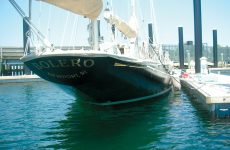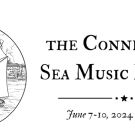
Edgartown — as viewed from its lighthouse — is an upscale town with pricey restaurants, lovely shops and pristine beaches. Photo by Marilyn Pond Brigham
Story and photos by Marilyn Pond Brigham
For Points East
Martha’s Vineyard is a beautiful, wind-swept island off the south coast of Cape Cod that’s only accessible by water or air. Of course, the best way to explore the Vineyard is by sea, with dinghy in tow, and discover the intricacies of its harbors for oneself.
The Native American Wampanoag people, who’ve lived in Martha’s Vineyard continuously for thousands of years, called the island, Noepe, meaning “land amid the waters.” Giovanni da Verrazzano, in the early 1500s (perhaps on his way to New York), named the island Louisa. Finally, in 1602, English explorer Bartholomew Gosnold settled the matter, calling the charming little landmass Martha’s Vineyard. Martha reportedly was his mother-in-law and/or daughter. “Vineyard” is from the wild grapes he noted on the island. These days, people call it simply the Vineyard.
No matter your approach to the island, you will cruise through Vineyard Sound or Nantucket Sound. The south coast of the Vineyard is generally inaccessible. You will travel along several notable shoals: Middle Ground, Hedge Fence and Squash Meadow. It’s best to avoid the large, named rocks, like Allegheny, Rhode Island, Lone, Allen, Hatsett and Mill. The island has 125 miles of tidal shoreline and five harbors. Over many years, and in various vessels, I have rich memories of memorable places, but I have no island favorite.
Let’s start with the westernmost:
Menemsha: Many Americans recognize Menemsha harbor as the setting for the 1975 movie “Jaws.” Its picturesque fishing shacks, complete with shark tails nailed to the graying shingles, made the perfect setting for the “summer resort ruined by the tyranny of a man-eating shark” movie. The harbor, like much of the Vineyard, has changed considerably over the last 40 years. What was once a small fishing hamlet, with several wharves lined with fishing shacks, has become a more developed, popular and congested port for commercial vessels and recreational boats.
To get there, make your way from Vineyard Sound to Menemsha Bight, Bell “1”, which marks the entrance to Menemsha Creek Inlet, and then to Menemsha Basin. My favorite memory of Menemsha is from a spontaneous weekend cruise from Falmouth. When we arrived, there was no room for us to tie up at the dock and no available mooring. The harbormaster’s office suggested we anchor outside the entrance to Menemsha Creek, in Menemsha Bight. Having no other choice, we did.
That evening, four adults in a small, inflatable dinghy had a wet ride to Menemsha Pond to have dinner at the Home Port restaurant. The Home Port is an island tradition. It serves great seafood (particularly lobster) in an unpretentious building right on the water. Dinner was well worth the long wait outside and the precarious return dinghy ride back to the boat in the dark.
Lake Tashmoo: A perennial favorite of New England cruisers is Lake Tashmoo, a large fresh (spring-fed and groundwater) and salt water coastal pond. It’s also a favorite afternoon destination for boaters, as it offers a quiet and picturesque place for picnicking, fishing and swimming in warm water. At the entrance to Lake Tashmoo is a sand bar that has recently been dredged. Nonetheless, exercise caution and pay attention to your depthsounder until you’ve come to the mooring field.
The entrance depth is five and a half feet at low water. A boatyard is there, but facilities for transients are limited. If you’re lucky, you may pick up someone’s mooring or find a good place to anchor. If so, take your dinghy and tie up at the Tisbury Town Dock, then take the short walk to the Vineyard Haven.
My most vivid memory of Lake Tashmoo is from a September cruise in the early ’70s with my family in Dad’s 25-foot Cape Dory. After cruising from the Cape, we spent a couple of lovely days in Lake Tashmoo, just enjoying hanging out on someone’s mooring, swimming and feeding the ducks and swans. We enjoyed the peacefulness of the lake and its lack of development.
On day three, we’d hoped to cruise to Cuttyhunk, but we woke up to the backside of a hurricane, with driving rain and wind. We felt fortunate to be in such a protected place to ride out the storm, but became frustrated, bored, worried, and a bit lonely after two additional days rocking on the mooring in the rain and wind.
Vineyard Haven: This is the island’s largest harbor and its main commercial center. When you ashore, don’t be surprised if signs say, “Welcome to Tisbury.” Vineyard Haven is one of its villages, and the names are used interchangeably. The entrance to the harbor is wide and dramatically marked by two lighthouses: West Chop Light at the summit of a high hill on the west side of the harbor and East Chop Light (on the east side, in Oak Bluffs. “Chop” is an English term meaning the entrance to a channel. It’s a busy harbor filled with commercial and pleasure boats, yacht races, and the large passenger/car ferries that connect the island to the mainland.
Plenty of moorings are generally available, and anchoring is permitted in particular areas in “outer” Vineyard Haven Harbor. This is outside the stone breakwater, which has at its end a 25-foot high, lighted navigational aid. Moorings are available through the Vineyard Haven Launch Service (VHF Channel 72, www.gannonandbenjamin.com) and the Town of Tisbury harbormaster, who can be reached on VHF Channel 9, www.tisburyma.gov. Of course, the Vineyard Haven Launch Service offers launch service as well.
We’ve spent many a choppy night on those moorings. As the harbor is open to the north, it can get bouncy. Vineyard Haven is not a good choice as a port of refuge in a nor’easter. One can see the attractive clubhouse of the Vineyard Haven Yacht Club from these moorings, but I don’t believe the club offers moorings.
A quieter place for overnight, if space is available, is behind the breakwater, where many moorings are in a tight space; contact the harbormaster. The Owen Park Town Dock, with the harbormaster’s office, does not provide dockage, but you can tie up there to load/unload (six feet of water at low tide). Dinghies may be tied up at the town dock or the Steamship Authority wharf, or they can be beached, except where marked as private.
We generally tie up at a slip at the Black Dog Wharf (VHF Channel 72, www.blackdogwharf.com), with lots of amenities: overnight dockage, showers, laundry facilities, and, my favorite, coupons for coffee and doughnuts at the Black Dog Bakery. And, it is close to town, for shopping, dining and provisioning (the Stop & Shop is right across the street from the bakery).
The Tall Ships Shenandoah and Alabama, moored just off the dock, are always fun to see, at rest or under sail. A favorite memory is a late fall visit, when we were the only boat tied at the wharf. Upon awakening early one morning, I ventured into the cockpit in my nightgown, only to discover a group of artists painting at the end of the dock. They paid me no attention.
Other marinas there are Vineyard Haven Marina (VHF Channel 9, www.vineyardhavenmarina.com), just down the harbor from the Black Dog Wharf. It also offers a range of services, and caters to large vessels. Martha’s Vineyard Shipyard (VHF Ch. 73, www.mvshipyard.com) is a working boatyard near the head of the harbor. It, too, has an array of marine services, including transient moorings in Lagoon Pond. Access to Lagoon Pond is through the drawbridge (VHF Channel 16) for vessels drawing less than six feet. If you’re not able to get your boat in there, it’s a fun place to explore with your dinghy.
Vineyard Haven is just plain fun. Walk around town, browse through the shops (books, clothes, jewelry, gifts), eat ice cream, dine – and keep an eye out for visiting ex-Presidents (Clinton and Obama) and A-list celebrities. My favorite spots include the Black Dog Tavern (great seafood right on the harbor), the Copper Wok (a Chinese/Pan Asian restaurant on Main Street), Mad Martha’s (also on Main, for ice cream), and the Bunch of Grapes bookstore (with books by island authors).
You can rent bikes at Martha’s Bike (at Five Corners on Lagoon Pond Road) or catch the MVTA bus, in front of the Steamship Authority Terminal, to explore the island. A good walk down Main Street leads you to Owen Park, just off Main Street, where there’s a nice beach, a picnic spot, the harbormaster’s office, and restrooms.
In 2014, we saw the whaling barque Charles W. Morgan (then 173 years old) berthed in Vineyard Haven, in the midst of her historic sail up the New England coast. The Morgan had visited Martha’s Vineyard to honor islanders’ contributions to her lucrative whaling career.
Oak Bluffs: This port is a well-protected harbor. The Oak Bluffs Marina (VHF Channel 71, www.oakbluffsmarina.com), is the largest marina on the island and is managed by the town. It has 81 slips, 50 moorings (their launch is hailed on VHF Channel 77), and med-moors for large yachts. The harbor is surrounded by the main drag, Lake Street, and is not far from Circuit Avenue, where restaurants, shops and bars abound. In season, Oak Bluffs is popular, with lots of activity, nightlife and noise. Not far away is the dock for the Steamship Authority’s seasonal ferry.
Beginning in the mid-19th century, Oak Bluffs welcomed the Methodists. Make the short walk to Trinity Park to see the Tabernacle and the surrounding Camp Meeting Association grounds, which feature more than 300 multi-colored, elaborately trim-med Carpenter Gothic architecture “gingerbread” cottages. Also worth the walk is Ocean Park, with its gazebo, which is a great place to picnic, fly a kite, or just absorb the view of the Mainland.
Shopping, people watching, and restaurants are best found around Circuit Avenue. Check out the Flying Horses Carousel, the nation’s oldest continuously operatingcarousel. Riding that carousel is a favorite memory of my youth; I was too small to catch the brass ring, but I tried. A more recent favorite memory is of savoring fresh-baked apple fritters at Back Door Doughnuts.
Edgartown: Edgartown’s early history is one of whaling, evidenced by the town’s many white-clapboard Federal and Greek revival homes with widow’s walks. Some of these are private homes; many are boutique hotels or B&B’s. All are picture-perfect. Edgartown is an upscale town with pricey restaurants, lovely shops, and the pristine beaches of Chappaquiddick (known as “Chappy”), Katama and South Beach. Even the launch driver in Katama Bay wears a tie – a Vineyard Vines one, of course.
The channel to Edgartown Harbor is well-marked. You’ll see the cheery and colorful beach cabanas of the Chappy Beach Club by the entrance to the harbor and, on the opposite side of the channel, the Edgartown Lighthouse. Don’t be distracted by the pretty homes, large hotels, church spires, harbormaster’s office, Town Dock, and the imposing Edgartown Yacht Club (EYC): The 64-foot car/passenger ferries, On Time II and On Time III, cross the 527-foot channel in both directions, seemingly nonstop. Also, lots of pleasure boats spill in and out of the busy channel from Katama Bay. Best to stay focused.
Moorings in Katama Bay are either private or offered by the harbormaster. Reservations must be made in advance (with Dockwa, www.dockwa.com or the harbormaster, www.edgartownharbor.com), which means, generally, way in advance. No more first-come, first-served moorings, and no grabbing a mooring for the day. Vessels must have their reservations and hail the Harbor Master (VHF Ch 74) for an assignment when they enter the harbor.
Anchorage is available in the outer harbor, south and east of N “8”, alongside Chappaquiddick Beach. Launch service is available from the moorings and the anchorage to the floating docks near the EYC via Oldport Launch (VHF Channel 68). Dinghies can tie up to the harbormaster’s floating dock to drop off trash, buy ice, and use showers and restrooms. Edgartown has two other places to tie up your boat: the Harborside Inn (VHF Channel 10) and Mad Max Marina (VHF Channel 71). Reservations also must be made in advance.
We enjoy walking around town. The village is beautifully maintained, with the ever-present scent of boxwood hedges and views of blue hydrangea. Walk along North and South Water streets to admire the attractive homes and front yards. I’ve gathered yellow, white and gray scallop shells on Lighthouse Beach, later fashioning them into Christmas decorations for my home. Each time we cruise to Edgartown, we take a dinghy cruise of Katama Bay. We enjoy the quiet beauty of Caleb’s Pond, across from Edgartown on Chappy, and the expanse of the bay all the way down to South Beach, on the southern side of the Island. Along the way, we’ll see commercial oyster farms, osprey nests, and many, large summer homes.
The Vineyard is about 96 square miles in area, some 20 miles long, and is made up of six quaint towns – the rural hamlets of West Tisbury, Chilmark and Aquinnah, and the busier port towns of Tisbury, Oak Bluffs and Edgartown. Each is different in character, with productive farms, quiet marshes, wide and sandy beaches, sloping clay cliffs, large lagoons and astounding beauty. About one-third of the island is protected from development.
All of the Vineyard harbors and their towns present many things, real and intangible, to savor and stow in a cruiser’s memory bank. Step on land and explore each of them by foot, rental bike, or via the excellent public bus system, the Martha’s Vineyard Transit Authority (MVTA). See if you can decide on one, single favorite Vineyard experience. I never could.
Marilyn Brigham and her co-captain/spouse Paul sail Selkie, a Catalina 445, out of Quissett Harbor, Falmouth, Mass. She is a lifelong sailor and a current member of both the Quissett and Cottage Park yacht clubs. She hopes the 2019 sailing season finds Selkie cruising off the coasts of Massachusetts, Rhode Island, Connecticut and New York.










